- Center on Health Equity & Access
- Clinical
- Health Care Cost
- Health Care Delivery
- Insurance
- Policy
- Technology
- Value-Based Care
Novel, Automated Ventilatory Burden Measure Shows Promise to Gauge OSA Severity
Automated ventilatory burden can effectively assess obstructive sleep apnea (OSA) severity, estimate cardiovascular (CVD) mortality, and may present a promising alternative to apnea-hypopnea index (AHI).
Automated ventilatory burden can evaluate obstructive sleep apnea (OSA) severity effectively, predict all-cause and cardiovascular (CVD) mortality, and might be a promising alternative to the apnea-hypopnea index (AHI), according to findings published in the American Journal of Respiratory and Critical Care Medicine.1
OSA is a common chronic disease that affects over 1 billion people globally and is linked with symptoms like daytime sleepiness and long-term consequences of CVD morbidity and neurocognitive impairment. Presently, the existence of OSA is proven by the AHI.
AHI used for the diagnosis of OSA considers only the frequency or respiratory events and has noticeable limitations. Researchers proposed a novel automated measure called ventilatory burden (VB) to assess the proportion of overnight breaths with less than 50% normalized amplitude, and the study demonstrated its ability to overcome limitations of AHI.
heart pumping stock photos: © Dreamstime

First, 2 epidemiological cohorts, the Sao Paolo Epidemiological Study (EPISONO) and Sleep Heart Health Study (SHHS), were used for data extraction. Two retrospective clinical cohorts (DAYFUN; NYU Center for Brain Health) were used originate the normative range of VB, evaluate the relationship between degree of upper airway obstruction and VB, and to evaluate the relationship between VB and all-cause and CVD mortality with and without hypoxic burden (HB) that was originated using an in-house automated algorithm.
The 95th percentile of VB in healthy subjects without symptoms was 25.2% for the EPISONO cohort and 26.7% for DAYFUN cohort (median [interquartile range] VBEPISONO was 5.5% [3.5-9.7], median VBDAYFUN was 9.8% [6.4-15.6]). VB was linked with the degree of upper airway obstruction in a dose-response manner. The VB in untreated subjects was 31.6% (27.1), VB in suboptimally treated participants was 17.6% (18.7), VB in off-treatment participants was 41.6% (18.1).
VB also showed low night-to-night variability and predicted all-cause and CVD mortality in the SHHS cohort, prior to and following adjustment for covariates including HB. Even though AHI was predictive of all-cause mortality, it was not linked with CVD mortality in SHHS cohort.
Using data from numerous epidemiological and clinical cohorts making up 5,182 subjects, the researchers showed that the automated measure of VB in OSA strongly predicts CVD and all-cause mortality and is linked with daytime sleepiness and hypertension.
The AHI, especially the AHI4%, which shows the rate of hypopneas associated 4% or greater desaturations, is indirectly a combination of the 2 immediate consequences of OSA: ventilatory changes and associated intermittent hypoxia.
“Defining and characterizing OSA accurately and independently across these domains, rather than combining them into a single metric, may provide greater flexibility in defining utility and possibly overcome limitations of the AHI,” emphasized the researchers.
The normative value seen for VB (approximately 25% or lower) suggests that up to 25% of breaths during sleep might have decreased amplitude, a threshold below which adverse outcomes aren’t likely, and this threshold can be used to exclude or define OSA.
Additionally, their observations that the model with combined VB and HB possessed the highest concordance in fully adjusted models and improved on the models with either AHI or HB alone supported the idea of using disentangled, automated, and generalizable metrics across the ventilatory and hypoxic domains as opposed to using the AHI’s implicit, yet fixed, combination.
In a press release, corresponding author Ankit Parekh, PhD, assistant professor of medicine in the Division of Pulmonary, Critical Care and Sleep Medicine at the Icahn School of Medicine at Mount Sinai, said “We have developed a way to analyze routine sleep studies to predict risk of cardiovascular diseases and even mortality. Clinicians who rely on arbitrary rules and thresholds for assessing severity of sleep apnea will now have a better validated tool to better manage sleep apnea and patients can receive the best care earlier.”2
The researchers saw that the night-to-night variability in VB was low across in-lab and at-home polysomnography, which might further strengthen its use in the clinical management of OSA.
Presently, no gold standard other than the AHI exists for the presence of OSA or its severity. Because of that, it is hard to establish how VB as shown here relates to the true pathophysiology of OSA, which was a limitation of this study.
“The fully-automated nature of the ventilatory burden, coupled with straightforward interpretation and ties to patient-centered outcomes, make it an attractive alternative for deployment in routine clinical care as well as in research applications,” concluded the researchers.
References
1. Parekh A, Korey K, Wickramaratne S, et al. Ventilatory burden as a measure of obstructive sleep apnea severity is predictive of cardiovascular and all-cause mortality. Am J Respir Crit Care Med. Published online September 12, 2023. doi:10.1164/rccm.202301-0109OC
2. Mount Sinai researchers develop novel, automated measure of sleep studies to determine severity of obstructive sleep apnea. News Release. Mount Sinai. September 12, 2023. Accessed September 12, 2023. https://www.mountsinai.org/about/newsroom/2023/mount-sinai-researchers-develop-novel-automated-measure-of-sleep-studies-to-determine-severity-of-obstructive-sleep-apnea
